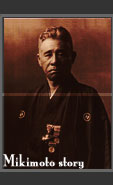| |
When Wang Fong and his
wife, Lai Mui, fled from China to Tahiti to make a better life for themselves
there, they could hardly have imagined that one of their own children
would grow up to become one of the most important citizens of their adopted
land. It is said that many years later, when Robert Wan finally visited
the village of his ancestors for the first time, he silently thanked his
father for letting him be born in Tahiti, thus giving him a chance to
fulfill a unique destiny, that of the pioneer of the Tahitian
pearl industry.
|
|
| |
Robert
Wan began his career at the age of nineteen. He started at an
accounting firm, moved to a shipping agency, an import export
wholesaler and an automobile dealership. He discovered cultured
pearls in 1973. The story actually goes back to 1963
when the government of Tahiti decided to support a cultured pearl
industry. A number of people tried their luck but were mostly
doomed to failure. Even the government's willingness to provide
support did not help.
In
1974, Robert Wan travelled to Japan where he met an expert on
pearl farming. This was Professor Sato who had worked with the
father of cultured pearl farming, Kokichi Mikimoto. Professor
Sato introduced Wan to Mikimoto's grandson who assured him that
he would be a confirmed buyer if Robert could produce quality
pearls. Three years later, Mikimoto would make good his promise
and buy Robert Wan's first pearl harvest and till today, Mikimoto
remains one of the biggest buyers of Robert Wan pearls.
|
|
|
| |
Mr. Robert Wan |
|
|
| |
Robert
Wan was ready to invest in pearls now. He came across a company
called Tahiti Perles set up by an Australian called William Reed.
When Robert bought the farm in 1974, it had yet to yield a harvest.
In 1984 he bought the atoll of Marutea Sud, which would go on to
produce the finest Tahitian pearls. In 1990, he added the atoll
of Nengo-Nengo to his acquisitions. This was a first for him because
this atoll was completely uninhabited. Today only 70 people live
there in a village cut off from the world. Robert Wan could carry
all this off because he passionately believed in the future of his
little "poe rava", which means black .pearls with green
reflections in the Tahitian language.
|
|
|
Robert
Wan's confidence in this capital intensive business was such that
although he had no idea how much money he would need to invest,
he used all the profits of his food producing business. He worked
hard. Hundreds of miles from Papeete, he had to start from scratch
to install his workers. Setting up the workers on the islands and
getting supplies to them and Wan had to invest in a small airplane.
The investment was extraordinarily heavy. Setting up pearl farms
on uninhabited or sparsely inhabited islands required setting up
of infrastructure, getting electric generators, fuel, building quarters
for the staff to stay, runways for the planes carrying supplies
to land, and a hundred other things that we in well populated areas
so easily take for granted. These expenses along with the small
scale of pearl production that Robert Wan started with on the advice
of experts ensured that it would be many years before this adventure
would even begin to recover its cost. |
|
Pearl
farming in Tahiti |
By
the end of the 1970's these small scale ventures had turned into
a fully organised pearl farm. In 1977, he sold his first harvest
to Mikimoto and in 1978, he made his first sale to Golay Buchel.
From the beginning Robert Wan made sure that he spent on the best
scientists, grafters and technicians and this is one of the secrets
of his success.
Cultured pearl farming is an uncertain business. The whims of nature
are way beyond human control and Robert Wan learnt this the heartbreaking
way. In 1996, a tropical depression hit the Nengo Nengo atoll (560
kms from Tahiti). The workers on the farm survived by lashing themselves
to coconut trees and waiting for the waters to subside. Houses and
installations were washed away and even the runway was ravaged and
pearl investments of several years were destroyed. Several years
of work and investment were washed away in a few hours. Not all
disasters are so spectacular however, parasites and predators such
as turtles and manta rays and sickness all threaten the oyster populations
in the lagoons.
|
|
Left to right : Pinctada
margaritifera or the black lipped pearl oyster.
Nucleating oysters. |
Nevertheless, there is a saying that a winner
never quits and a quitter never wins and Robert Wan was no quitter.
From 1995-2001, he continuously opened Tahiti Perles boutiques in
the Sheraton and Intercontinental hotels across French Polynesia,
in Tahiti, Moorea and Bora Bora.
However,
the most significant achievement was the First Robert Wan Tahitian
Pearl Auction in Hong Kong in 1998. Since then, these auctions,
along with the Paspaley Pearl Auctions are the most important events
of the pearl trade. Like Mikimoto for akoya and Paspaley for south
sea pearls, Robert Wan is the only name one thinks of when it comes
to the Tahitian pearl.
|
|
|
|
|





















